#Chasmosaurus belli
Note
If it hasn't been done yet, perhaps something on Chasmosaurus?
Ooh good choice!
How about a historical photo this time around?
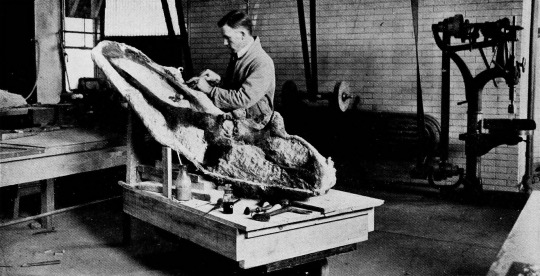
[ photo source ]
Here's George F. Sternberg (the same man who discovered a Xiphactinus audax with a recently eaten Gillicus arcuatus in its stomach!) preparing the skull of a Chasmosaurus belli aaall the way back 1914.
#ask#majingojira#Chasmosaurus#Dinosaur#Palaeontology#Paleontology#Cretaceous#Fossil#Prehistoric#Mesozoic#Ceratopsian#Photo#George F. Sternberg
57 notes
·
View notes
Photo

A quick study of Chasmosaurus belli.
Might do more size comparisons like those in the future, they're pretty fun.
Based on the skeletal by Scott Hartman.
#my art#paleoart#chasmosaurus#belli#dinosaur#ceratopsian#ceratopsia#chasmosaurinae#herbivore#ornithischia#animal#prehistoric#size comparison#extinct#north america#Dinosaur Park Formation#Dinosaur Park#cretaceous
10 notes
·
View notes
Text
Chasmosaurus belli, C. russelli

Chasmosaurus russelli by Jack Wood on @thewoodparable
PLEASE support us on Patreon! We really do need all of your support to keep this blog running - any amount helps!
Name: Chasmosaurus belli, C. russelli
Name Meaning: Opening Reptile
First Described: 1914
Described By: Lambe
Classification: Dinosauria, Ornithischia, Genasauria, Neornithischia, Cerapoda, Marginocephalia, Ceratopsia, Neoceratopsia, Coronosauria, Ceratopsoidea, Ceratopsidae, Chasmosaurinae, “Chasmosaurini”
(Note: Chasmosaurini is not a valid clade name, rather an informal name I have given to those Chasmosaurines found to be more closely related to Chasmosaurus than to Triceratops in the phylogeny of Brown et al., 2014)
Chasmosaurus is one of the more famous Chasmosaurines, named for the large openings in its skull. Known from many specimens, it is only known from the Dinosaur Park Formation of Alberta, Canada, with the two species coming from different beds of the formation: Chasmosaurus russelli being from the older, lower portion of the formation, dating to about 76.5 to 76 million years ago; and Chasmosaurus belli coming from the younger, middle portion, about 76 to 75.5 million years ago. Neither had a very long timespan, only existing in the Campanian age of the Late Cretaceous for about 500,000 years apiece, but they still left their mark on their environments, and on our understanding of Ceratopsians on the whole.

By Sam Stanton on @artisticthingem
C. belli was about 4.8 meters long and two tonnes in weight, where C. russelli was 4.3 meters long and 1.5 tonnes in weight. Apart from that, their differences are mainly based upon the shape of the horns and frill; C. russelli had longer brow horns that were more curved backwards than that of C. belli. Their other major differences are based upon the size of their osteoderms on the frill. Its large openings in the frill were triangular, with points going outward to the corner of the frill, different than the circular openings of other Ceratopsians. Skin impressions are known from this genus, including hexagonal and pentagonal scales, which were evenly spaced among smaller scales. It had a long snout and jaws, allowing it to be more selective in the plant material it consumed; the frill itself was probably used more for display than anything given the fragility caused by the large holes, and the horns were also too small to be used in display. Juveniles are known of this genus, as pictured above; and it is thought that Chasmosaurus cared for its young. The adults were not fast moving and neither were the babies, which were probably protected by the adults. The frill was narrower in the back as a baby and shorter, as were the horns; all of these attributes would have filled out as the baby grew.

Chasmosaurus belli by José Carlos Cortés on @ryuukibart
The Dinosaur Park Formation was a fluvial channel environment, with overbanks and floodplains, very close to the Western Interior Seaway. C. russelli lived alongside such dinosaurs as Dyoplosaurus, Edmontonia, Euoplocephalus, Scolosaurus, Spinops, Corythosaurus, Gryposaurus, Parasaurolophus, Hanssuesia, and Gorgosaurus, which probably preyed upon it. C. bellii lived alongside many other dinosaurs too, some of which overlapped with C. russelli, such as Edmontonia, Euoplocephalus, Panoplosaurus, Centrosaurus, Styracosaurus, Corythosaurus, Lambeosaurus, Parasaurolophus, Prosaurolophus, Gorgosaurus, and Daspletosaurus, the latter two probably preyed upon it. As such, Chasmosaurus was a fairly constant in these communities.
Sources:
https://en.wikipedia.org/wiki/Dinosaur_Park_Formation
https://en.wikipedia.org/wiki/Chasmosaurus
Shout out goes to @pinkpeachkiss-blog!
#chasmosaurus#chasmosaurus belli#chasmosaurus russelli#dinosaur#ceratopsian#palaeoblr#feathered chasmosaurus#paleontology#prehistory#prehistoric life#dinosaurs#biology#a dinosaur a day#a-dinosaur-a-day#dinosaur of the day#dinosaur-of-the-day#science#nature#factfile#pinkpeachkiss-blog#Dìneasar#डायनासोर#ديناصور#ডাইনোসর#risaeðla#ڈایناسور#deinosor#恐龍#恐龙#динозавр
89 notes
·
View notes
Photo


Chasmosaurus belli in the shade
764 notes
·
View notes
Photo
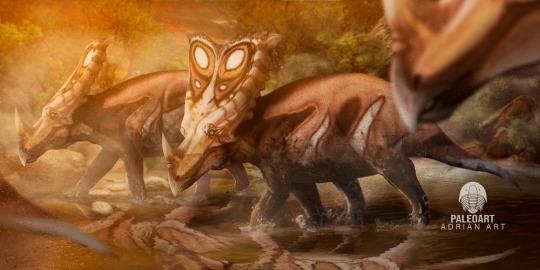
Chasmosaurus belli
Paleoart by AdrianArt
90 notes
·
View notes
Photo
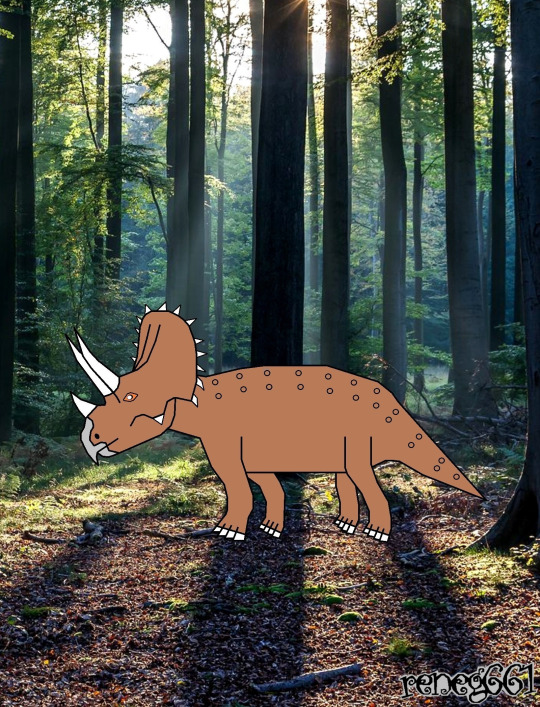
Is a genus of ceratopsid dinosaur from the Upper Cretaceous Period of North America. Its name means 'opening lizard', referring to the large openings (fenestrae) in its frill (Greek chasma meaning 'opening' or 'hollow' or 'gulf' and sauros meaning 'lizard'). With a length of 4.3–4.8 metres (14.1–15.7 ft) and a weight of 1.5–2 tonnes (1.7–2.2 short tons), Chasmosaurus was a ceratopsian of average size. Like all ceratopsians, it was purely herbivorous. It was initially to be called Protorosaurus, but this name had been previously published for another animal. All specimens of Chasmosaurus were collected from the Dinosaur Park Formation of the Dinosaur Provincial Park of Alberta, Canada. Referred specimens of C. russelli come from the lower beds of the formation while C. belli comes from middle and upper beds.
Herbivore
Chasmosaurus (c) Carnivores
Art (c) reneg661
2 notes
·
View notes
Text
Chasmosaurus belli


Colorations are based on Beast Of The Mesozoic’s Chasmosaurus figure, one of which I got from Christmas.
I’m hoping to draw their Triceratops (sub-adult) as I got ahold of one recently along with a Zuniceratops
16 notes
·
View notes
Photo
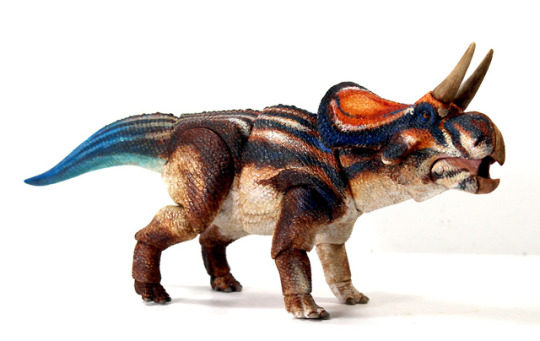

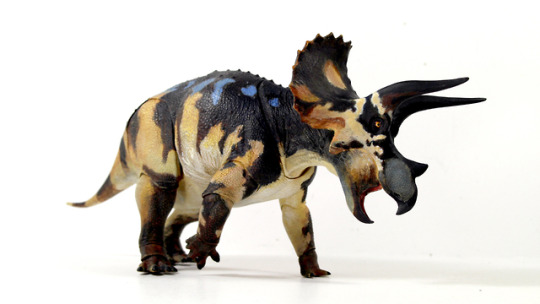

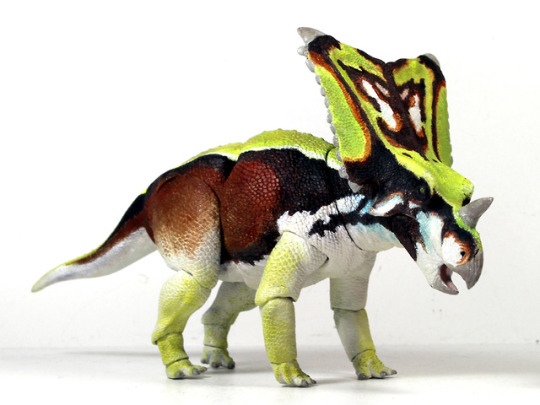
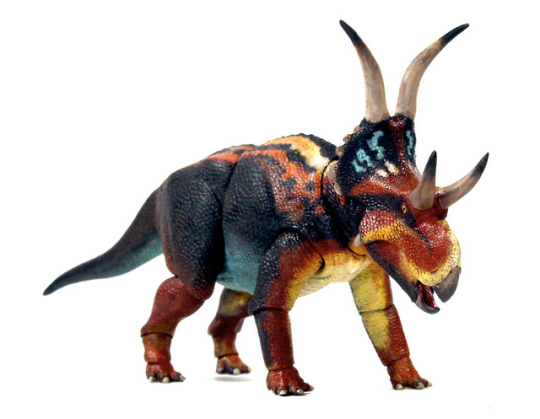



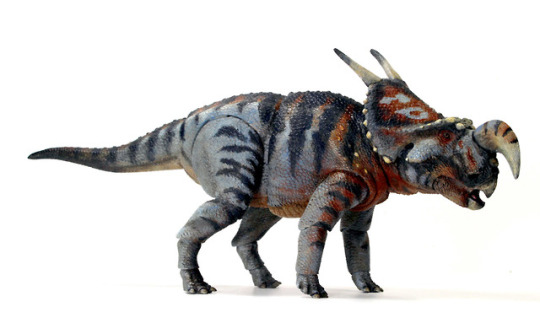
One of my favorite toy makers “Creative Beast Studio” held a very successful kickstarter for his Beasts of the Mesozoic: Raptor Series Action Figures and is now doing the same thing for a Ceratopsian set of figures! There’s still a few days left to help unlock as many figures as possible for a huge range to choose from and each figure comes with some amazing box art and packaging to boot. Please share if you can and/or donate to help out this amazing creator and get some scientifically accurate and beautiful dinosaur figurines. More information and pictures are on the kickstarter page for each and every figure.
CLICK HERE TO VISIT THE KICKSTARTER PAGE
#beasts of the mesozoic#ceratopsian#dinosaurs#paleo#action figures#crowdfunding#kickstarter#toys#If anyone knows me well I LOVE DINOSAURS SO MUCH#I really wanna see as many of these unlocked as possible#there is a huge variety and the toy market desperatly needs more scientifically accurate dinosaur options
573 notes
·
View notes
Photo
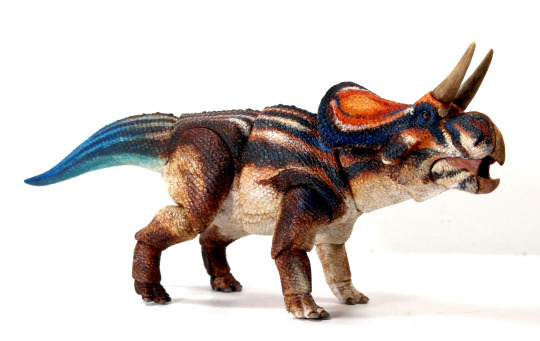






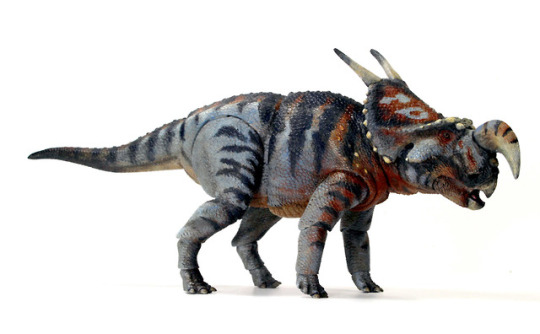

Beasts of the Mesozoic: Ceratopsian Series – What’s been unlocked*
Zuniceratops christopheri
Monoclonius crassus
Triceratops horridus (sub-adult)
Styracosaurus albertensis
Chasmosaurus belli
Diabloceratops eatoni
Nasutoceratops titusi
Einiosaurus procurvicornis
Avaceratops lammersi
Kosmoceratops richardsoni
Spiclypeus shipporum
Protoceratops andrewsi
Psittacosaurus mongoliensis
Medusaceratops lokii
Regaliceratops peterhewsi
The Kickstarter campaign ends Thu, October 17 2019 7:00 PM UTC +03:00.
https://www.kickstarter.com/projects/creativebeast/beasts-of-the-mesozoic-ceratopsian-series-action-figures/
*last edited 17 October 2019
#palaeoblr#beasts of the mesozoic#zuniceratops#monoclonius#triceratops#styracosaurus#chasmosaurus#diabloceratops#nasutoceratops#einiosaurus#avaceratops#kosmoceratops#spiclypeus#toys and collectibles
265 notes
·
View notes
Text

The Survivor: Chasmosaurus belli
It wasn't her first tangle with a tyrannosaur. Predators seek out the weak as easy prey, and new predators in this territory invariably think they've found that in Olivia. They are invariably educated otherwise. There are two types of tyrannosaur in Olivia's neighborhood - those who under-estimate her, and those with matching scars.
88 notes
·
View notes
Photo

Chasmosaurus belli skeleton on display at the Royal Ontario Museum.
#Chasmosaurus#Chasmosaurus belli#Ceratopsian#Dinosaur#Museum#Royal Ontario Museum#ROM#Photo#Skeleton#Mesozoic#Cretaceous
261 notes
·
View notes
Photo
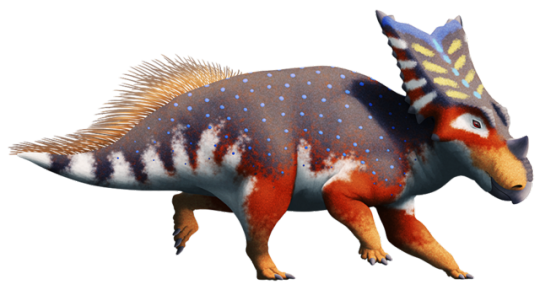
Ceratopsian Month #23 -- Chasmosaurus belli
The basis for the whole chasmosaur grouping of the ceratopsids, Chasmosaurus (“chasm lizard”) lived about 76-75 million years ago in Alberta, Canada. Two different species are currently recognized within the genus, with the smaller C. russeli found in older rock layers and the type species C. belli being slightly younger.
Many different fossils are known, including a juvenile, with C. belli adults reaching a size of around 4.8m (15’8”). Different individuals display a lot of variation in their ornamentation, especially in the size and curve of their brow horns -- and some specimens even lost their brow horns completely, with the bony cores being resorbed with age.

It shared its habitat with its distant relative Centrosaurus, but since Chasmosaurus had a longer narrower snout than its centrosaur cousin it probably fed on different types of vegetation.
Skin impressions are also known from around the right hip region on one specimen, showing large scales in spaced-out horizontal rows among much smaller scales.
#science illustration#paleontology#paleoart#palaeoblr#ceratopsian month 2017#chasmosaurus#chasmosaurini#chasmosaurinae#ceratopsidae#neoceratopsia#ceratopsian#marginocephalia#neornithischia#ornithischia#dinosaur#archosaur#art
132 notes
·
View notes
Photo

Here's the first chasmosaurine color concept art for the Beasts of the Mesozoic Chasmosaurus belli action figure! The green mantella frog was the color inspiration for this one. #beastsofthemesozoic #creativebeaststudio #dinosaur #actionfigures #ceratopsian #toys #chasmosaurus #toydesign #conceptart #prehistoric #reptiles #wildlife #paleontology #naturalhistory #kickstarter https://www.instagram.com/p/Bs5z3Nplspb/?utm_source=ig_tumblr_share&igshid=1toc76uundif5
#beastsofthemesozoic#creativebeaststudio#dinosaur#actionfigures#ceratopsian#toys#chasmosaurus#toydesign#conceptart#prehistoric#reptiles#wildlife#paleontology#naturalhistory#kickstarter
0 notes
Note
For my fav ceratopsians Chasmosaurus belli and C. russelli: Common Bannerface and Long-Horned Bannerface, respectively, in reference to the likely ornamental function of their frills and C. russelli's longer brow horns.
Ooooooo
8 notes
·
View notes
Text
Episode 119 is all about Chasmosaurus, a ceratopsid that lived in the Cretaceous in North America.
We also share listener Vince’s experiences at Discover the Dinosaurs. Here are some photos he was kind enough to share:
#gallery-0-6 { margin: auto; } #gallery-0-6 .gallery-item { float: left; margin-top: 10px; text-align: center; width: 25%; } #gallery-0-6 img { border: 2px solid #cfcfcf; } #gallery-0-6 .gallery-caption { margin-left: 0; } /* see gallery_shortcode() in wp-includes/media.php */
Do you like dinosaur t-shirts? Join our community on Patreon now to get an Allosaurus t-shirt!
https://www.patreon.com/iknowdino
Thank you to all our current Patreon supporters!
You can listen to our free podcast, with all our episodes, on iTunes at:
https://itunes.apple.com/us/podcast/i-know-dino/id960976813?mt=2
In this episode, we discuss:
News:
Scientists discovered a new Jurassic sauropodiform dinosaur, Xingxiulong chengi, found in China, according to Nature
Auburn University is raising money to house its only dinosaur egg
The Backroom at the Field Museum in Chicago has a pop-up bar/museum exhibit starting March 25th
A 12-year-old girl discovered an Edmontosaurus, and it has been nicknamed after her.
20 animatronic dinosaurs are coming to Atlanta starting March 30th
The Port Lympne Animal Reserve has added a Spinosaurus to its Dinosaur Forest
The University of Lisbon, Portugal launched a new website, called Paleowire to share news, events, job opportunities, and more related to paleontology
Sideshow Collectibles has a new Gastonia with an optional pterosaur for $349
Science has a great overview of early feathered dinosaurs and which could likely fly
A stage production used lights to simulate dinosaurs in New Orleans
New research demonstrates how sauropods’ vertebrae interlocked for added strength
ScienceOpen.com has added papers from the Journal of Paleontological Techniques to their collection of Open Access papers
Dinosaur survival VR game Island 359 was demoed at GDC with full body tracking
Giant dinosaur statues are on display at Singapore’s Gardens by the Bay
An amazing new interactive map is available on paleobiodb.org where you can look up local fossil finds
New research in the Journal of Theoretical Biology aims to answer why dinosaurs became bipedal
New Mexico paleontologists have apparently discovered a close relative to Triceratops in their archives
After a $100 million renovation, the Witte Museum in San Antonio, Texas is back open with new high-tech dinosaur features
The dinosaur of the day: Chasmosaurus
Ceratopsid that lived in the Cretaceous in North America
Name means “opening lizard,” named that because of large openings in its frill
Found in the Dinosaur Park Formation of the Dinosaur Provincial Park of Alberta, Canada
Two species: Chasmosaurus russelli and Chasmosaurus belli (type species)
Chasmosaurus russelli is in the older lower Dinosaur Park Formation and Chasmosaurus belli is in the middle Dinosaur Park Formation
Lawrence Morris Lambe found the first Chasmosaurus bones in 1897 (holotype, part of a neck frill). He thought it could be a new species but categorized it as an already known genus, Monoclonius. He called it Monoclonis belli
Species name belli is in honor of collector Walter Bell
In 1913, Charles Sterberg and his sons found a few complete Monoclonis bellis skulls in Alberta (plus a largely complete skeleton with skin impressions), and in January 1914, Lambe named them Protorosaurus (as an ancestor to Torosaurus). But that name was already used for a Permian reptile found in Germany, described in 1836 by Meyer. So Lambe renamed it Chasmosaurus in February 1914
Many skulls and fossils have been referred to Chasmosaurus, and many species named (though only two are still valid)
Barnum Brown named Chasmosaurus kaiseni in 1933 (based on a skull that had long brow horns), which may be related to Chasmosaurus canadensis, named in 1990 by Thomas Lehman.
Chasmosaurus canadensis was originally Monoclonis canadensis (Lambe had found it in 1902 and described it as Eoceratops canadensis in 1915). This Eoceratops and Chasmosaurus kaiseni were thought to be Mojoceratops (Nicholas Longrich), but some scientists think Mojoceratops is a synonym of Chasmosaurus russelli. In 2016, Campbell and others found that Eoceratops and Chasmosaurus kaiseni were Chasmosaurus.
In 1933 Richard Swann Lull named a specimen Chasmosaurus breviorstris (had a short snout), but it’s now seen as a junior synonym of Chasmosaurus belli.
Charles Mortram Sternberg named Chasmosaurus russelli in 1940 (species name in honor of Loris Shano Russell).
In 1987 Gregory Paul renamed Pentaceratops sternbergii into Chasmosaurus, but no one has really accepted that
In 1989 Thomas Lehman described Chasmosaurus mariscalensis (found in Texas), but that’s been renamed Agujaceratops.
In 2000, George Olshevsy renamed Monoclonius recurvicornis (originally named in 1889) to Chasmosaurus recurvicornis, but it’s now a nomen dubium
In 2001, Chasmosaurus irvinensis was named, but has since been renamed Vagaceratops (in 2010)
Chasmosaurus was about 14-16 ft (4.3-4.8 m) long and weighed 1.5-2 tons
Skin impressions that Charles Sternberg found had large scales in horizontal rows that were among smaller scales (hexagonal or pentagonal), unclear about color
Had three horns, one on the nose and two on the brow
Horns were short, though Chasmosaurus russelli had longer horns (esp. brown horns), that were more curved backwards
Chasmosaurus belli had a v-shaped frill at the back (Chasmosaurus russelli is more of a shallow u-shape)
Sides of the frill had osteoderms
Not clear what Chasmosaurus used its horns and frill for (horns were short and frill had such large openings, so not great for defense). May have used its beak for defense instead
Frill may have been to look more vicious or for thermoregulation, or to attract mates (may have been brightly colored)
Skin covered the large openings so it would have looked like a solid frill (because of soft tissue in the frill, it’s possible Chasmosaurus could have flushed and made its frill look more vivid)
Had a longer snout and jaws than other ceratopsians it lived around, so may have been a pickier eater
May have taken care of its young
Phil Currie and a team found a juvenile Chasmosaurus belli in Alberta. Thought to be three years old and had similar limb and frill proportions to an adult, so probably wasn’t that fast, and didn’t need to be to keep up with adults
Chasmosaurinae is a subfamily of ceratopsid
Chasmosaurinae had large brow horns and long frills (compared to centrosaurines, another subfamily of ceratopsid, which had short brow horns and shorter frills with long spines coming out of the frills)
Chasmosaurine fossils have been found in western Canada, the western United States, and northern Mexico.
Fun fact: The first dinosaurs were carnivorous, later some dinosaurs were omnivorous, and eventually some dinosaurs were herbivorous. Herbivores were massively successful by the mid-Jurassic.
Allosaurus T-shirt (Limited Time!)
We have an Allosaurus t-shirt on sale at Teespring. Hurry, it’s only up for sale until March 27! Special thanks to artist Josh Cotton, the Doodling Dino, for the awesome drawing. Get it here:
teespring.com/iknowdino and we now have kids sizes available at teespring.com/iknowdinokids
I Know Dino Podcast Show Notes: Chasmosaurus (Episode 119) Episode 119 is all about Chasmosaurus, a ceratopsid that lived in the Cretaceous in North America.
2 notes
·
View notes
Video
youtube
I bet if I did this regularly I’d find some disagreements with exactly which fossils this program chose, but here’s a program covering their choices for 12 of the best-preserved fossils on Earth, including eggs, insects, pollen, nerve remnants, and so on. The study of how fossils are preserved is called Taphonomy and each of these would, in their own way, be an example of Exceptional Preservation.
From the million year old Mexican Beetle, to the crazy dinosaur eggs found recently, these are 12 BEST Preserved Fossils !
An Egg-strordinary Find --In southeast China, workers laying new sewage pipe were surprised to discover a clutch of fossilized dinosaur eggs at their worksite. 43 eggs were discovered, 19 of which were completely intact.
Rocks on the Lochs -- If you’re feeling old, check out this rock … it contains well-preserved fossils of life forms thought to have lived over a billion years ago. That’s billion with a ‘B’. These fossil-bearing rocks were found on the edge of a remote Scottish loch in 2011 … and it’s thought the life forms once lived at the bottom of lakes a billion years ago. While considered primitive, these organisms had specialized cell structures including a nucleus and could reproduce sexually, helping to speed up evolution. Scientists believe that land plants and green algae ultimately evolved from these organisms.
Scorpion Fossil -- An amazing fossil discovery, said to have been found by a farmer in a dirt pit dug by hand. This 2 centimeter male scorpion was unearthed in the amber-rich Chiapas Highlands of Mexico. Fossilized scorpions are rare, let alone complete ones. Taking a close look at these pictures by Francisco Riquelme revealed the entire body of the scorpion perfectly preserved in amber. From one angle, its tail seems poised to strike, like the animal could suddenly spring to life and burst out of its ancient tomb. The detail and clear features are really amazing. The specimen is tentatively dated between 15 to 23 million years old, and is considered a new species. Did you know more than 258 scorpion species have been found in Mexico?
Fossilized eggs the size of a button are said to contain the remains of the world’s oldest lizard embryos. Discovered in Thailand in 2015, scientists were able to peer inside the eggs by using synchrotron x-ray scanning … and it appeared the embryos were ready to hatch at the time of their death. Researchers had expected to find remains of a primitive bird species, or perhaps a small dinosaur inside the eggs … finding the ancient lizards was unexpected. About the size of sparrows eggs, they are hard-shelled, which is considered unusual for lizards. Dated at 125 million years old, the eggs belonged to a lizard related to the Komodo Dragon, which lived during the Cretaceous period. The ancient lizard species has yet to be named.
In 2015, outback Queensland was the site of a huge haul of fish fossils that dated back 100 million years. But one fish fossil in particular stood out … details in the fossil were so clearing defined, you can even make out its eye socket! No wonder it caught many people's eyes. That fish was a Cooyoo and measured nearly 10 feet long with teeth around an inch long. It also had a powerful tail, and researchers think it probably targeted larger fish. While scientists were jubilant about the find, the Cooyoo doesn’t seem all that happy. Then again, if you were fossilized for 100 million years, maybe you wouldn’t feel like whooping it up either!
Even if you don’t like insects, you might feel for this creature trapped in Burmese amber ages ago. This is a female scale insect from the Mesozoic period, and she’s carrying 60 eggs on her back in an effort to protect her offspring. In Bo Wang’s photo, you can see the eggs and freshly hatched nymphs encased in a wax coated egg sac located on the insect’s abdomen. This is actually the earliest evidence of insect brood care that dates to at least 100 million years ago. It’s a way of protecting their young from inclement conditions as well as from natural enemies. This amber fossil is very unique since fossilized examples of such animal behavior are exceedingly rare.
Alberta Canada’s Dinosaur Provincial Park is known to have one of the world’s richest deposits of dinosaur fossils in the world. In 2010, paleontologist Philip Currie discovered what might have been the find of his career. It was a baby Chasmosaurus (kaz-moe-sore-us) belli … the first intact fossil of its kind, with a near-complete skeleton …only the creature’s arms are missing, thought to have been eroded away thousands of years ago by a sinkhole. You can see the incredible detail in Clive Coy’s picture. The skull in particular is notably intact, as is the vertebrae. The horned, plant-eating Chasmosaurus was a relative of the Triceratops, and grew to around 16 feet long. Currie’s discovery measures around 1.5m long and died 72 million years ago, thought to have been about three years old. Because larger animals usually ate or destroyed smaller dinosaurs, it’s likely the Chasmosaurus was preserved away from predators in a river bed after drowning.
#Lagerstätte#geology#Geologist#Fossil#FossilFriday#Taphonomy#Exceptional preservation#Science#Research#amber#heart#insect#Santana#Pollen#Nerve#icthyosaur
105 notes
·
View notes